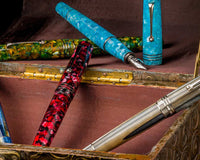For almost all pen collectors, there comes a point when they want to become more involved in their hobby. Some people branch out by trying new inks with unusual properties, some try out all the different types of paper they can possibly find, and some decide that custom grinds are more enjoyable to write with than regular round-tipped nibs.

However, when it comes to custom grinds, they can be very expensive to get done by a professional nibmeister. That is why I (a nibmeister myself) am going to walk you through the steps of grinding a basic stub nib in this article.
The steps presented in this article are the same ones I used to grind my first stub nib when I was still learning. Be warned that going through the actions described below may very well void the warranty of whatever pen you decide to use for this project.
With that out of the way, let’s get right into grinding your first stub nib!
Supplies Needed:
- 800 and 1500 grit sandpaper
- Micro mesh (12000 grit sandpaper)
- 10x loupe
- Brass shims
- Paper of your choice
- Fountain pen with medium or broad nib

Step One: Alignment
Before doing any type of nibwork, I always check the alignment of the nib’s tines. Grinding a nib with misaligned tines could result in permanent damage to the nib, essentially rendering the pen or nib unit useless.
To check the alignment of the tines, look at the nib straight on with your magnifying loupe. When looking at the nib straight on, you will see the round ball of tipping material. If it is misaligned, one side of the ball will be higher than the other.

With your fingernail, push the higher side down so it matches up with the lower side. When you stop pushing down, the higher side may spring back up, making the nib misaligned again. If this happens, continue to push down for a few seconds at a time, until the two tines stay lined up. This process may take a few tries, so just be patient and gentle with your nib!

Step Two: Grinding
Now that you have a nib with aligned tines, it is time to start grinding! You will first use the 800 grit sandpaper to do the shaping, and then the 1500 grit sandpaper to do finishing touches and to get the nib ready for the micro mesh.
To start off, grind the tipping material on the back of the nib until it is flattened. Make sure to keep the pen as flat and straight in relation to the sandpaper as possible.

Once done with the back, you will do the same with the front writing side of the nib. When grinding on the writing side, make sure to take it slow and frequently check your work under the loupe, as this is the side that really matters, when it comes to writing experience.


Once both the top and bottom of the tipping material have been nicely flattened, hold the pen at a 90° angle in relation to the sandpaper. Gently grind the “nose” of the nib down, giving the nib more of a square-shaped profile. This will allow the side strokes to be thinner than the vertical strokes, which is just what you want in a good stub nib.

With all of the preliminary grinding done, it is time to move onto the 1500 grit sandpaper.
With this, you will first want to repeat all of the steps given above. Repeating the steps with the 1500 grit sandpaper will start the polishing process, helping to prepare the nib for tuning and smoothing.
Once done, remove any sharp areas from the grind by slowly rolling the pen up as you drag it along the sandpaper. Using this technique, you get to choose how sharp or round your stub nib is, allowing the potential amount of line variation to be fully customizable to your preferences!
Step Three: Tuning and Smoothing
To finish off this amazing custom stub grind, we are going to give the nib a nice tune and smooth.
To start off, run your brass shim through the tines a few times. This will remove any unwanted debris from the nib that grinding may have left.

Next, ink up your pen and write with it a bit. This will give you an idea of the amount of feedback that the 1500 grit sandpaper left on the nib, helping you to ascertain just how much smoothing you would like to do with the micro mesh.
Once your assessment of the nib is complete, draw figure eights on the micro mesh at various angles to give the nib a thorough smoothing. As you smooth the nib out on the micro mesh, frequently scribble with it on the paper of your choice to get an idea of how much more smoothing you would like the nib to receive.

Continue to smooth the nib until you are happy with the results! When finished, admire your hard work, write a few letters with your new custom ground nib, and let me know how it turned out in the comments below!

Written by EndlessPens Blogger Arlo Palmer








2 comments
Bill
Thanks,
That worked very well. Great confidence booster for future grinding attempts.
Kate
This is fabulous, thank-you! I just did my first-ever nib grind yesterday using the method described here (although I haven’t done the final smoothing step yet, as I’m still waiting for my micromesh to arrive). I used a fine nib and am really happy with the result so far. The scratchiness is a bit annoying, but that’s just because I haven’t gotten the smoothing done yet. It’s not stopping me from using and enjoying the nib, though! I expected to ruin a couple of nibs before making a grind that I liked, so I am quite pleasantly surprised.